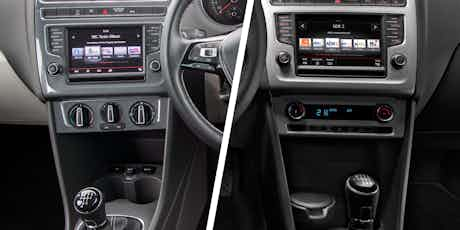Air conditioning vs climate control – what’s the difference?
June 28, 2017 by Mike Vousden

Back in the 1930s, car manufacturers started to offer a brand new option: electric heaters built into the dashboard.
Then, a few years later, Nash Motors, which went out of business in 1954, came up with a way to run fresh air past the engine. The engine heated the air, the air heated the cabin and the cabin kept the passengers toasty. Everyone was happy.
We’ve come a long way since then and it’s now pretty unusual to find a car that doesn’t have air conditioning as standard. Air con augments Nash’s ventilation system with a cooling capability, using a compressor to lower the temperature – much like a fridge.
Many cars now come with climate control, either as standard or an option. It’s a natural progressional from air conditioning, just as air con was a logical step up from heating and ventilation.
Let us explain…

Heating and ventilation
This is the most basic system, and it features in every car. It only has the capacity to blow warm air into the cabin or ventilate it by letting in air at ambient temperature – that is, the temperature outside. So, if you’re driving through the Australian outback, you’re going to be fairly uncomfortable.
Air conditioning
This adds the capacity to cool the ventilated air to below the ambient temperature. It works by cycling refrigerant fluid through a compressor and an evaporator to suck the heat energy from the air entering the cabin.
Air conditioning in cars can typically only be set to one temperature across the entire car. The cabin occupants can then set the fan speed and degree of cooling, which in turn determines the temperature inside the vehicle. You generally just choose whether you want it cooler or hotter than it currently is, rather than picking a particular temperature.

Climate control
Climate control goes one step further, using extra sensors and a computer to allow more precise management of the cabin temperature. Crucially, the system is easier to use than air conditioning because the cabin occupants set the desired temperature.
By doing this rather than fiddling with specific air conditioning settings, occupants don’t need to think about how much heating or cooling they want – instead, they let the computer work it out for them. Once the system has reached the desired temperature, it levels off to maintain it.
Many climate control systems also let occupants set their own personal temperatures. These are typically called dual-zone (for left and right sides) or tri-zone (left and right front passengers, and the rear). So, no more fighting over familial temperature disputes!

Which should you get?
This is often determined by your budget and choice of car.
If a car has air con as standard and climate control as an option, we’re inclined to say ignore it. Setting your air con isn’t hard (just not as easy as climate control) and the money you save could be better spent on integrated sat-nav.
However, if you’re looking at the more prestigious end of the showroom, you might want to consider adding climate control if it’s not standard. Why? Because it could make your car more attractive on the used market. That’s not to say it would be worth any more, but it should sell quicker when the time comes.
Be cool
If you want to see more of carwow’s handy-yet-easy-to-read guides take a look at our latest guide posts. If you’re interested in buying a car, check out our car configurator to find out how much you could save on your perfect motor. Or, to see a range of fantastic discounts, head over to our deals page.